Introduction to Astronomy
The Four Pillars of Big Bang Cosmology
There are four key observations that provide convincing evidence that the Universe began with the
'Big Bang'. The first two observations were formative---they made
people think there might have been a Big Bang. The second two are predictive---if the Big Bang happened, in the way we think it did, then we should be able to look out in the Universe and observe these two things. We took the predictions of the theory, and went looking for those things in space. We would not still hold the Big Bang as the standard model if these predictions were not born out by observation. At this
point in time, Big Bang cosmology is the standard model, accepted by most
scientists, no matter how uncomfortable or mind-boggling we find it!
- Olbers' Paradox: You've made this observation yourself, thousands of times. The sky is dark at night. See?:
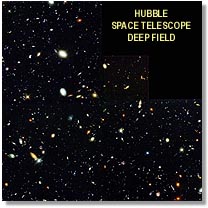 Duh, you say. That's the POINT of night-time! But this simple
observation leads to a simple question with a not-so-simple answer.
'Why is the sky dark at night?' is the question. Because the Universe
had a beginning, is the answer.
Consider a Universe which is infinite in size, and also
infinite in age. In this case, you have a Universe which has an
infinite number of stars in it, all grouped into an infinite number of
galaxies, which are further grouped into walls and voids. If this is the Universe that we live in,
then in any direction you look in the sky, you should see light coming
from those stars and galaxies.
Duh, you say. That's the POINT of night-time! But this simple
observation leads to a simple question with a not-so-simple answer.
'Why is the sky dark at night?' is the question. Because the Universe
had a beginning, is the answer.
Consider a Universe which is infinite in size, and also
infinite in age. In this case, you have a Universe which has an
infinite number of stars in it, all grouped into an infinite number of
galaxies, which are further grouped into walls and voids. If this is the Universe that we live in,
then in any direction you look in the sky, you should see light coming
from those stars and galaxies.
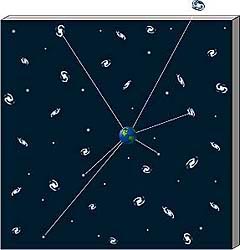 It's like standing in a forest. If the forest is very large, then any
direction you look, you will see a tree. To you, the
horizon will be uniformly tree-colored. Similarly, if the Universe is infinite,
then any direction you look, you should see a star. To you, the entire
sky should be uniformly 'star-colored', i.e. bright. In an infinite
Universe, the sky should be bright at night. UNLESS... unless the
Universe is not infinitely old. If the Universe has existed for only a
finite period of time, then the light from the most distant objects
hasn't had time to get here yet, and we should have a mostly dark sky.
Which we do! Thus this simple question has a not-so-simple answer---the
Universe had a beginning.
Aside: there is another way out of this paradox. The Universe might
not be infinite in size. The observable Universe might be the entire
thing. But this is unsavory for several reasons. The most
straight-forward of these is that if the observable Universe is the
entire thing, then we must be at the center of the actual Universe. How
many times do we have to make fools of ourselves before we stop
thinking that we are so special that we would be at the center of
things?! At least three, apparently... So it is generally accepted,
without concrete proof, that the Universe is infinite in size, just so
we don't make the same dumb mistake one more time.
If Olbers' Paradox was all the information we had, no one would be convinced. But it's not.
It's like standing in a forest. If the forest is very large, then any
direction you look, you will see a tree. To you, the
horizon will be uniformly tree-colored. Similarly, if the Universe is infinite,
then any direction you look, you should see a star. To you, the entire
sky should be uniformly 'star-colored', i.e. bright. In an infinite
Universe, the sky should be bright at night. UNLESS... unless the
Universe is not infinitely old. If the Universe has existed for only a
finite period of time, then the light from the most distant objects
hasn't had time to get here yet, and we should have a mostly dark sky.
Which we do! Thus this simple question has a not-so-simple answer---the
Universe had a beginning.
Aside: there is another way out of this paradox. The Universe might
not be infinite in size. The observable Universe might be the entire
thing. But this is unsavory for several reasons. The most
straight-forward of these is that if the observable Universe is the
entire thing, then we must be at the center of the actual Universe. How
many times do we have to make fools of ourselves before we stop
thinking that we are so special that we would be at the center of
things?! At least three, apparently... So it is generally accepted,
without concrete proof, that the Universe is infinite in size, just so
we don't make the same dumb mistake one more time.
If Olbers' Paradox was all the information we had, no one would be convinced. But it's not.
- The Expanding Universe: Einstein, in the early years
of the last century, predicted that the Universe is unstable (i.e.
expands or contracts). He hated this. He was uncomfortable, and didn't
like it, and didn't believe it, and was, in fact, so uncomfortable that
he invented a 'fudge factor' for his equations in order to force the
Universe to sit still. He admitted that he was fudging his numbers,
that he was making things up, but he couldn't help himself. An unstable
Universe would mean a beginning (and an end!), and he couldn't accept it.
Then, in the 1920's, Hubble came along, and observed the
velocities and distances of galaxies, and determined that the Universe
was, in fact, expanding.
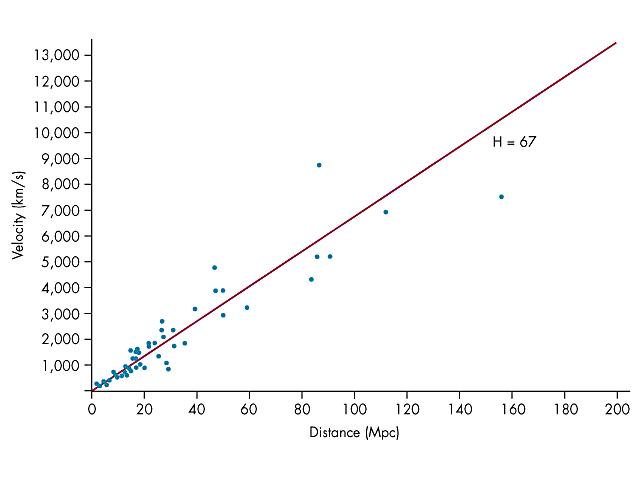 Einstein was wrong. The Universe does change with time.
Einstein called his fudge factor 'the biggest blunder' of his life. In the end, he
was driven by his intellectual honesty to accept a changing Universe,
but sadly missed making one of the greatest astronomical discoveries of
all time, because he was trapped by his preconceived notions of how the
Universe SHOULD be. He was a human being, after all...
What does an expanding universe mean? Out there, we see a relatively cold,
low-density Universe that is decreasing in density all the time. What
happens if we 'play the movie in reverse'? The Universe comes to higher and
higher densities, getting hotter and hotter. At some point in the
distant past, the Universe was extremely hot, and extremely dense (but
still infinite in size---it hurts your head to think about, I know!).
So extremely hot and dense, in fact, that matter as we know it didn't
exist. The entire Universe was much like the singularity of a black
hole---too hot and too dense for our physics to describe. This is a
hot, dense beginning to the Universe. After this, the Universe expands
outward. We define this hot, dense beginning as a Big Bang.
Einstein was wrong. The Universe does change with time.
Einstein called his fudge factor 'the biggest blunder' of his life. In the end, he
was driven by his intellectual honesty to accept a changing Universe,
but sadly missed making one of the greatest astronomical discoveries of
all time, because he was trapped by his preconceived notions of how the
Universe SHOULD be. He was a human being, after all...
What does an expanding universe mean? Out there, we see a relatively cold,
low-density Universe that is decreasing in density all the time. What
happens if we 'play the movie in reverse'? The Universe comes to higher and
higher densities, getting hotter and hotter. At some point in the
distant past, the Universe was extremely hot, and extremely dense (but
still infinite in size---it hurts your head to think about, I know!).
So extremely hot and dense, in fact, that matter as we know it didn't
exist. The entire Universe was much like the singularity of a black
hole---too hot and too dense for our physics to describe. This is a
hot, dense beginning to the Universe. After this, the Universe expands
outward. We define this hot, dense beginning as a Big Bang.
- The Helium Abundance: This is one of the 'predictive'
observations. If there was a Big Bang, we should be able to say
something about the amount of helium in the Universe, and thereby test
the Big Bang. If the predicted values are nothing like the actual
values, the Big Bang is trash, and we must throw it out (or at least makes some serious modifications!). The basic idea is that the
Universe starts out hot, and then cools down pretty fast, as it
expands. This means that there was a time when the conditions were
exactly right to form Helium in the entire Universe all at once. But after
that, nearly every place in the Universe was too cold, and too diffuse
for fusion (except, of course, in
the centers of stars!). Theory predicts the amount of Helium in the
Universe should be about 25% (10% from the Big Bang, and ~15% since
then, made in stars). So, observers set out to measure the fraction of Helium in the Universe. The fact that we still talk about the Big Bang should tell you that the theory and the observations agree!
- The Cosmic Microwave Background Radiation (CMBR):
This is the second of the 'predictive' observations. If there was a Big
Bang, we should be able to test the predictions of the theory. Remember that if the
predictions are nothing like the observed reality, the Big Bang is
trash, and we can throw it out and start over. But if they agree with observed reality, our confidence in the theory grows, and we build on that knowledge.
The very early Universe was extremely hot and dense---like the center
of the Sun. Imagine yourself at the center of the Sun. You couldn't
even see your hand in front of your face, even if it was in a special
melt-proof suit. Why? Because the Sun is opaque---light can't travel
freely through the Sun! The early Universe was too hot for atoms
to form, so light never traveled very far at once before it was
absorbed. As the temperature falls, atoms begin to form, and the
Universe becomes transparent at ~100,000 years after the Big Bang.
Radiation is decoupled from matter---i.e. is free to move about space.
This is the decoupling era. After this, the Universe is
matter-dominated. The radiation that was liberated at that time should
still be moving through space, and it is. We observe it as the Cosmic Microwave
Background Radiation.
The existence of CMBR and its detection were nearly simultaneous
(astronomically speaking). There's a rather funny story about Penzias
and Wilson building a radio telescope and thinking the hiss they were
receiving came from pigeons. But it didn't. It came from the Big Bang,
as they later figured out.
In 1989 and 1990, a spacecraft named the Cosmic Background
Explorer (COBE) was launched, and observed the CMBR. The observations made by this satellite are shown in the graph below. The dots are the data, and the line is the theory. The error bars (how far wrong the observations could be) are smaller than the dots. These observations
were among the best agreements between theory and prediction ever in
astronomy. This is a triumph of modern astrophysics---it's so amazing
that at the meeting where it was announced, the team received a
standing ovation for their work.
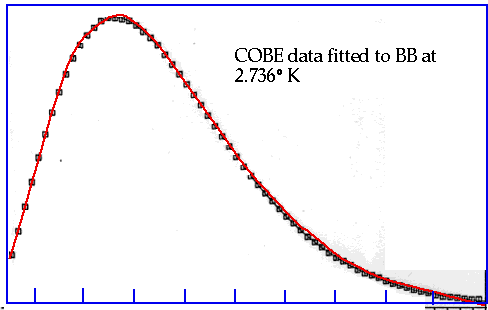 When the CMBR was emitted, the Universe had a temperature of 3000 K.
But it looks to us like a blackbody at 3 (actually 2.736) K. How can
this be?
Cosmological Redshift: the Universe is stretching (expanding). As the
light travels through it, it gets stretched too, so becomes longer
wavelength, which means the light has a lower frequency, therefore is redder, and so looks like a cooler object.
Here is a picture of the CMBR over the whole sky, with the
picture oriented so that the Milky Way is in the middle of the picture.
When the CMBR was emitted, the Universe had a temperature of 3000 K.
But it looks to us like a blackbody at 3 (actually 2.736) K. How can
this be?
Cosmological Redshift: the Universe is stretching (expanding). As the
light travels through it, it gets stretched too, so becomes longer
wavelength, which means the light has a lower frequency, therefore is redder, and so looks like a cooler object.
Here is a picture of the CMBR over the whole sky, with the
picture oriented so that the Milky Way is in the middle of the picture.
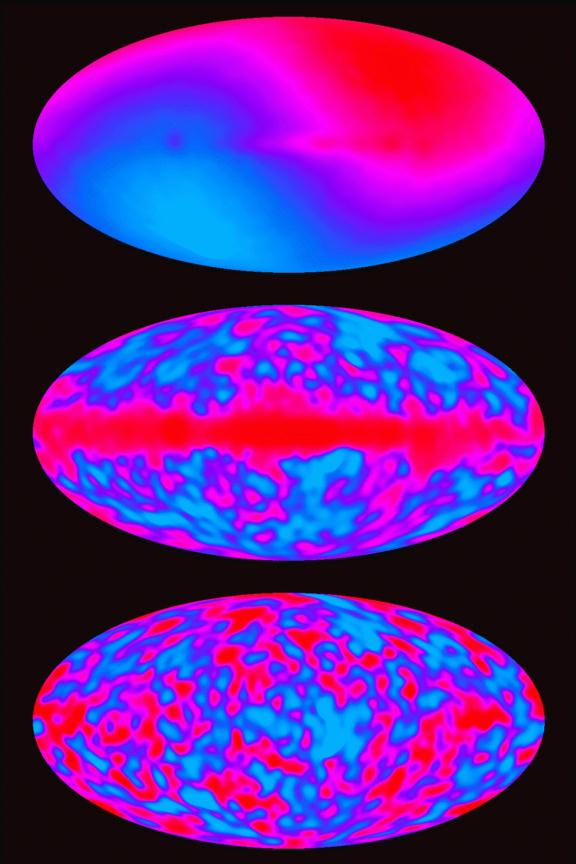 The first panel in the above image includes variations in the
CMBR due to the fact that the Sun travels around the center of the
Galaxy. But this is a very well known phenomenon, and we can subtract
it out to get...
the second panel, which includes contributions to the CMBR from
nearby stuff (such as dust and gas in our own Galaxy). But our own
Galaxy is pretty well observed, and so we can make a model of it and
subtract it out to get...
the third panel. This panel shows the CMBR as it comes to us
from a few hundred thousand years after the Big Bang. It is critical
for you to realize what you are looking at. You are looking at light
which has been traveling to you since the instant the Universe
became transparent. This is the earliest we will ever be able to see,
EVER. You are looking at the Universe when it was very, very young,
even before any stars or galaxies formed. Wow! I mean, seriously. Stop a moment, go for a walk, ant think about that. Go on. We'll wait.
Welcome back! From the picture of the CMBR all over the sky, we can
find out some things about the Universe. First,
the CMBR is remarkably isotropic (same in all directions). The red and
blue bumps that you see differ by only one part 10,000 from the average
CMBR temperature of 2.73 K. This means that one part might be 2.7301 K,
and another part might be 2.7299 K. To you and me, that's pretty much
identical. This proves that the temperature and density were nearly
uniform everywhere in the Universe at decoupling.
These variations, however, are important, because they are probably
density enhancements that eventually formed galaxies and galaxy clusters.
In fact, we can predict what the size of these fluctuations should be,
given that we have such and so many galaxies in our current Universe,
spread out to a given density. So, of course, we made a model of the
Universe, which predicts that the size of the red and blue blobs (the
'fluctuations') should average one degree on the sky (if the Universe
is flat, among other things...). The Australians sent up a balloon
(called Boomerang) to measure the fluctuations. Take a look at the results:
The first panel in the above image includes variations in the
CMBR due to the fact that the Sun travels around the center of the
Galaxy. But this is a very well known phenomenon, and we can subtract
it out to get...
the second panel, which includes contributions to the CMBR from
nearby stuff (such as dust and gas in our own Galaxy). But our own
Galaxy is pretty well observed, and so we can make a model of it and
subtract it out to get...
the third panel. This panel shows the CMBR as it comes to us
from a few hundred thousand years after the Big Bang. It is critical
for you to realize what you are looking at. You are looking at light
which has been traveling to you since the instant the Universe
became transparent. This is the earliest we will ever be able to see,
EVER. You are looking at the Universe when it was very, very young,
even before any stars or galaxies formed. Wow! I mean, seriously. Stop a moment, go for a walk, ant think about that. Go on. We'll wait.
Welcome back! From the picture of the CMBR all over the sky, we can
find out some things about the Universe. First,
the CMBR is remarkably isotropic (same in all directions). The red and
blue bumps that you see differ by only one part 10,000 from the average
CMBR temperature of 2.73 K. This means that one part might be 2.7301 K,
and another part might be 2.7299 K. To you and me, that's pretty much
identical. This proves that the temperature and density were nearly
uniform everywhere in the Universe at decoupling.
These variations, however, are important, because they are probably
density enhancements that eventually formed galaxies and galaxy clusters.
In fact, we can predict what the size of these fluctuations should be,
given that we have such and so many galaxies in our current Universe,
spread out to a given density. So, of course, we made a model of the
Universe, which predicts that the size of the red and blue blobs (the
'fluctuations') should average one degree on the sky (if the Universe
is flat, among other things...). The Australians sent up a balloon
(called Boomerang) to measure the fluctuations. Take a look at the results:
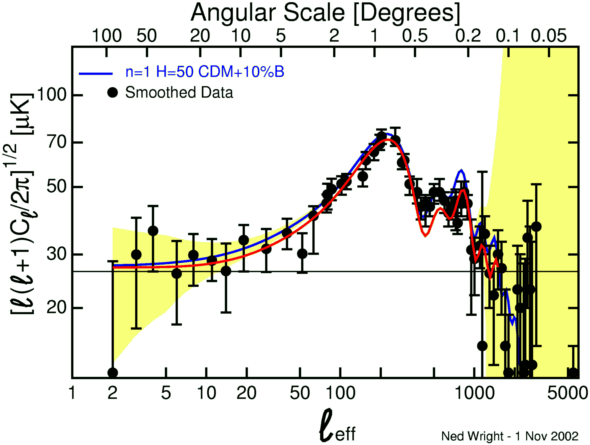 This is a pretty complicated graph, so let me point out that the y-axis
fundamentally tells you the number of the red or blue blobs. The top x-axis is
the important one, and it tells you how big the blobs are. So that each data point
tells you the number of blobs of a given size. You can see from the plot that most
of the blobs in the CMBR are about 1 degree on the sky.
This is the size predicted by Big Bang models of a flat Universe! Here we
have further evidence that the curvature of the entire Universe is flat.
This is a pretty complicated graph, so let me point out that the y-axis
fundamentally tells you the number of the red or blue blobs. The top x-axis is
the important one, and it tells you how big the blobs are. So that each data point
tells you the number of blobs of a given size. You can see from the plot that most
of the blobs in the CMBR are about 1 degree on the sky.
This is the size predicted by Big Bang models of a flat Universe! Here we
have further evidence that the curvature of the entire Universe is flat.
Finally, here is a terrific plot, which reduces all of the
above argument about cosmology and curvature to a single picture. This
plot contains a lot of information! It shows you all of the possible
Universes, which you could ever invent in your head or in your
computer, along with their ends and their beginnings, as predicted by
the value of Omega. Omega could have lots of different values in all
these Universes. This plot helps us figure out what Omega is for OUR
Universe, because we can put data taken in our Universe on this plot,
and therefore include some values of omega-naught and exclude others.
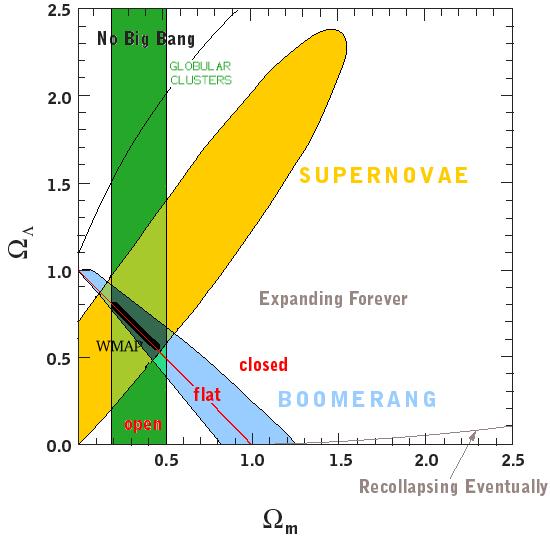 The axes in this plot are the two parts of omega. The x-axis is
the matter part (omega-matter), and the y-axis is the 'vacuum energy'
part (omega-lambda) (you remember vacuum energy---that's the stuff
that's pushing the Universe out and accelerating it---not very well
explained at this time, and not definitely detected, but as the plot
shows, there is something there.) The sum of these two equal omega.
The axes in this plot are the two parts of omega. The x-axis is
the matter part (omega-matter), and the y-axis is the 'vacuum energy'
part (omega-lambda) (you remember vacuum energy---that's the stuff
that's pushing the Universe out and accelerating it---not very well
explained at this time, and not definitely detected, but as the plot
shows, there is something there.) The sum of these two equal omega.
- The red line shows you where omega is 1. i.e. the region of the plot which gives a flat Universe.
- In the upper left of the plot, you can see that if
omega-lambda is much much larger than omega-matter, then there was no
Big Bang.
- In the lower right of the plot, you can see that if
omega-matter is much much larger than omega-lambda, the Universe will
eventually recollapse (because it weighs so much that the mass will
pull it all back together again).
- Above and to the right of the red line, where the plot says closed,
the curvature is positive, so the Universe is finite yet unbounded. In
the region above the gray 'recollapsing' line, the Universe will expand
forever.
- Below and to the left of the red line, the curvature is negative, and the Universe is infinite, and will not recollapse.
Where does the actual Universe lie on this plot? Well, we have lots of data
that can help us figure this out.
- The first available data came from studies of the ages of globular clusters. This is the vertical green bar. We didn't get a whole lot of information out of that, except to say that the mass fraction in the Universe had to be between 0.2 and 0.5. If the big green bar was all the information we had, we'd be very unsatisfied. And we were. So we went out and did more experiments. It's important to note, however, that this green bar means that anything OUTSIDE of it can't be a good description of the Universe we live in. So that's something!
- The yellow blob shows the region of the plot allowed by Supernova data. These data are used to measure quite precisely the expansion of the Universe. Anything
outside of this blob is highly unlikely to be the location of the real
Universe.
- The blue blob shows the region
allowed by the Boomerang data. Anything outside of this blob is highly
unlikely to be the location of the real Universe. We now have a region where the three sets of observations overlap! The overlapping
region tells you where our Universe is very strongly likely to be on this plot. From this
plot, and the overlap, we can see that the Universe is very nearly
flat, and that omega-lambda is actually a larger part of omega than
omega-matter.
- In recent times, we took it one step further, with a satellite called the 'Wilkinson Microwave Anisotropy Probe' (WMAP---isn't that a great name?!), which examined the red and blue blobs in vastly more detail. That's the black line. You see that it overlaps the other three regions. One particular astronomer I know was really disappointed by this. It means that we actually understand the physics really, really well. Sigh. No new physics to discover. Too bad.
Current cosmological studies are trying hard to add more constraints to
this plot. It is important to note that these data must be independent
of each other in order to add NEW information.
One last thing. Notice that none of these data allow the
possibility that there was no Big Bang. All of the data lie in the
portion of the plot which means that a Big Bang happened. The evidence
mounts that this really IS the way the Universe began. No matter how
difficult it may be to imagine it!
But, three questions remain for theory to answer about the Big Bang.
- Strucure? What causes fluctuations?
- Flatness? Why is omega-nought so close to 1?
- Horizon? Why is Universe so isotropic when one edge can't have communicated with the other within the age of the Universe?






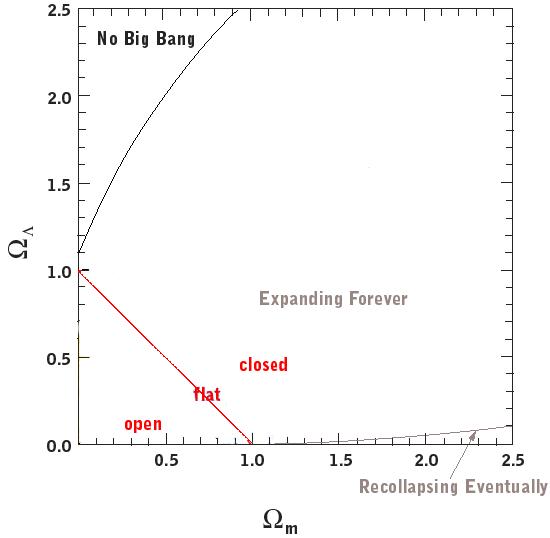
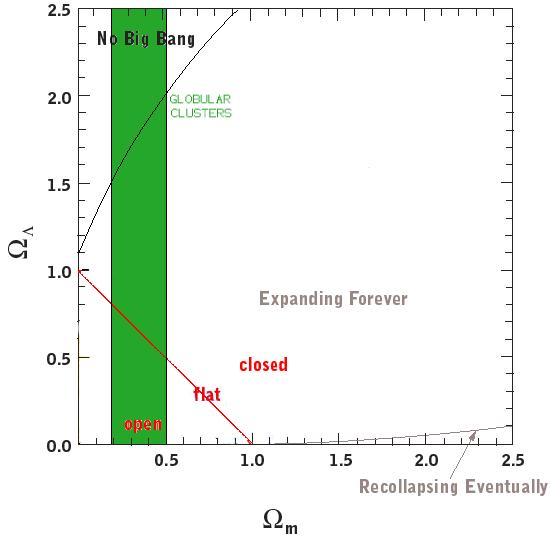
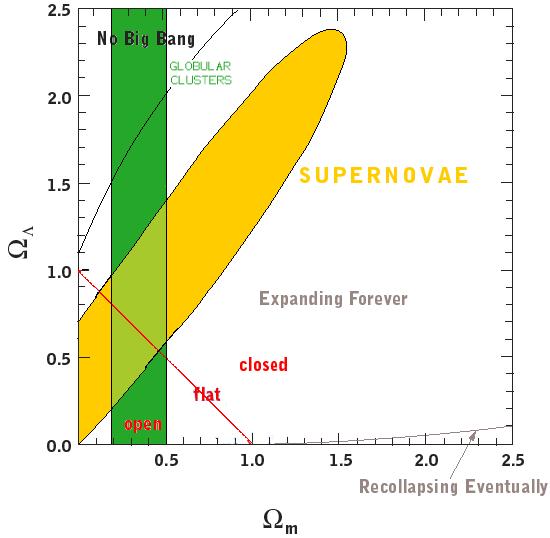
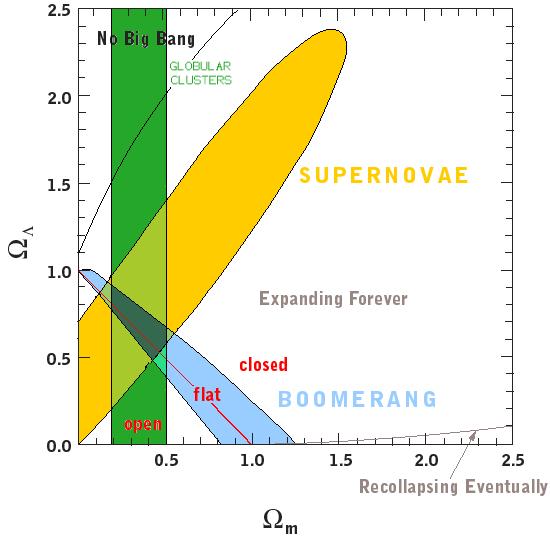












 Duh, you say. That's the POINT of night-time! But this simple
observation leads to a simple question with a not-so-simple answer.
'Why is the sky dark at night?' is the question. Because the Universe
had a beginning, is the answer.
Consider a Universe which is infinite in size, and also
infinite in age. In this case, you have a Universe which has an
infinite number of stars in it, all grouped into an infinite number of
galaxies, which are further grouped into walls and voids. If this is the Universe that we live in,
then in any direction you look in the sky, you should see light coming
from those stars and galaxies.
Duh, you say. That's the POINT of night-time! But this simple
observation leads to a simple question with a not-so-simple answer.
'Why is the sky dark at night?' is the question. Because the Universe
had a beginning, is the answer.
Consider a Universe which is infinite in size, and also
infinite in age. In this case, you have a Universe which has an
infinite number of stars in it, all grouped into an infinite number of
galaxies, which are further grouped into walls and voids. If this is the Universe that we live in,
then in any direction you look in the sky, you should see light coming
from those stars and galaxies.
 It's like standing in a forest. If the forest is very large, then any
direction you look, you will see a tree. To you, the
horizon will be uniformly tree-colored. Similarly, if the Universe is infinite,
then any direction you look, you should see a star. To you, the entire
sky should be uniformly 'star-colored', i.e. bright. In an infinite
Universe, the sky should be bright at night. UNLESS... unless the
Universe is not infinitely old. If the Universe has existed for only a
finite period of time, then the light from the most distant objects
hasn't had time to get here yet, and we should have a mostly dark sky.
Which we do! Thus this simple question has a not-so-simple answer---the
Universe had a beginning.
Aside: there is another way out of this paradox. The Universe might
not be infinite in size. The observable Universe might be the entire
thing. But this is unsavory for several reasons. The most
straight-forward of these is that if the observable Universe is the
entire thing, then we must be at the center of the actual Universe. How
many times do we have to make fools of ourselves before we stop
thinking that we are so special that we would be at the center of
things?! At least three, apparently... So it is generally accepted,
without concrete proof, that the Universe is infinite in size, just so
we don't make the same dumb mistake one more time.
If Olbers' Paradox was all the information we had, no one would be convinced. But it's not.
It's like standing in a forest. If the forest is very large, then any
direction you look, you will see a tree. To you, the
horizon will be uniformly tree-colored. Similarly, if the Universe is infinite,
then any direction you look, you should see a star. To you, the entire
sky should be uniformly 'star-colored', i.e. bright. In an infinite
Universe, the sky should be bright at night. UNLESS... unless the
Universe is not infinitely old. If the Universe has existed for only a
finite period of time, then the light from the most distant objects
hasn't had time to get here yet, and we should have a mostly dark sky.
Which we do! Thus this simple question has a not-so-simple answer---the
Universe had a beginning.
Aside: there is another way out of this paradox. The Universe might
not be infinite in size. The observable Universe might be the entire
thing. But this is unsavory for several reasons. The most
straight-forward of these is that if the observable Universe is the
entire thing, then we must be at the center of the actual Universe. How
many times do we have to make fools of ourselves before we stop
thinking that we are so special that we would be at the center of
things?! At least three, apparently... So it is generally accepted,
without concrete proof, that the Universe is infinite in size, just so
we don't make the same dumb mistake one more time.
If Olbers' Paradox was all the information we had, no one would be convinced. But it's not.
 Einstein was wrong. The Universe does change with time.
Einstein called his fudge factor 'the biggest blunder' of his life. In the end, he
was driven by his intellectual honesty to accept a changing Universe,
but sadly missed making one of the greatest astronomical discoveries of
all time, because he was trapped by his preconceived notions of how the
Universe SHOULD be. He was a human being, after all...
What does an expanding universe mean? Out there, we see a relatively cold,
low-density Universe that is decreasing in density all the time. What
happens if we 'play the movie in reverse'? The Universe comes to higher and
higher densities, getting hotter and hotter. At some point in the
distant past, the Universe was extremely hot, and extremely dense (but
still infinite in size---it hurts your head to think about, I know!).
So extremely hot and dense, in fact, that matter as we know it didn't
exist. The entire Universe was much like the singularity of a black
hole---too hot and too dense for our physics to describe. This is a
hot, dense beginning to the Universe. After this, the Universe expands
outward. We define this hot, dense beginning as a Big Bang.
Einstein was wrong. The Universe does change with time.
Einstein called his fudge factor 'the biggest blunder' of his life. In the end, he
was driven by his intellectual honesty to accept a changing Universe,
but sadly missed making one of the greatest astronomical discoveries of
all time, because he was trapped by his preconceived notions of how the
Universe SHOULD be. He was a human being, after all...
What does an expanding universe mean? Out there, we see a relatively cold,
low-density Universe that is decreasing in density all the time. What
happens if we 'play the movie in reverse'? The Universe comes to higher and
higher densities, getting hotter and hotter. At some point in the
distant past, the Universe was extremely hot, and extremely dense (but
still infinite in size---it hurts your head to think about, I know!).
So extremely hot and dense, in fact, that matter as we know it didn't
exist. The entire Universe was much like the singularity of a black
hole---too hot and too dense for our physics to describe. This is a
hot, dense beginning to the Universe. After this, the Universe expands
outward. We define this hot, dense beginning as a Big Bang.
 When the CMBR was emitted, the Universe had a temperature of 3000 K.
But it looks to us like a blackbody at 3 (actually 2.736) K. How can
this be?
Cosmological Redshift: the Universe is stretching (expanding). As the
light travels through it, it gets stretched too, so becomes longer
wavelength, which means the light has a lower frequency, therefore is redder, and so looks like a cooler object.
Here is a picture of the CMBR over the whole sky, with the
picture oriented so that the Milky Way is in the middle of the picture.
When the CMBR was emitted, the Universe had a temperature of 3000 K.
But it looks to us like a blackbody at 3 (actually 2.736) K. How can
this be?
Cosmological Redshift: the Universe is stretching (expanding). As the
light travels through it, it gets stretched too, so becomes longer
wavelength, which means the light has a lower frequency, therefore is redder, and so looks like a cooler object.
Here is a picture of the CMBR over the whole sky, with the
picture oriented so that the Milky Way is in the middle of the picture.
 The first panel in the above image includes variations in the
CMBR due to the fact that the Sun travels around the center of the
Galaxy. But this is a very well known phenomenon, and we can subtract
it out to get...
the second panel, which includes contributions to the CMBR from
nearby stuff (such as dust and gas in our own Galaxy). But our own
Galaxy is pretty well observed, and so we can make a model of it and
subtract it out to get...
the third panel. This panel shows the CMBR as it comes to us
from a few hundred thousand years after the Big Bang. It is critical
for you to realize what you are looking at. You are looking at light
which has been traveling to you since the instant the Universe
became transparent. This is the earliest we will ever be able to see,
EVER. You are looking at the Universe when it was very, very young,
even before any stars or galaxies formed. Wow! I mean, seriously. Stop a moment, go for a walk, ant think about that. Go on. We'll wait.
Welcome back! From the picture of the CMBR all over the sky, we can
find out some things about the Universe. First,
the CMBR is remarkably isotropic (same in all directions). The red and
blue bumps that you see differ by only one part 10,000 from the average
CMBR temperature of 2.73 K. This means that one part might be 2.7301 K,
and another part might be 2.7299 K. To you and me, that's pretty much
identical. This proves that the temperature and density were nearly
uniform everywhere in the Universe at decoupling.
These variations, however, are important, because they are probably
density enhancements that eventually formed galaxies and galaxy clusters.
In fact, we can predict what the size of these fluctuations should be,
given that we have such and so many galaxies in our current Universe,
spread out to a given density. So, of course, we made a model of the
Universe, which predicts that the size of the red and blue blobs (the
'fluctuations') should average one degree on the sky (if the Universe
is flat, among other things...). The Australians sent up a balloon
(called Boomerang) to measure the fluctuations. Take a look at the results:
The first panel in the above image includes variations in the
CMBR due to the fact that the Sun travels around the center of the
Galaxy. But this is a very well known phenomenon, and we can subtract
it out to get...
the second panel, which includes contributions to the CMBR from
nearby stuff (such as dust and gas in our own Galaxy). But our own
Galaxy is pretty well observed, and so we can make a model of it and
subtract it out to get...
the third panel. This panel shows the CMBR as it comes to us
from a few hundred thousand years after the Big Bang. It is critical
for you to realize what you are looking at. You are looking at light
which has been traveling to you since the instant the Universe
became transparent. This is the earliest we will ever be able to see,
EVER. You are looking at the Universe when it was very, very young,
even before any stars or galaxies formed. Wow! I mean, seriously. Stop a moment, go for a walk, ant think about that. Go on. We'll wait.
Welcome back! From the picture of the CMBR all over the sky, we can
find out some things about the Universe. First,
the CMBR is remarkably isotropic (same in all directions). The red and
blue bumps that you see differ by only one part 10,000 from the average
CMBR temperature of 2.73 K. This means that one part might be 2.7301 K,
and another part might be 2.7299 K. To you and me, that's pretty much
identical. This proves that the temperature and density were nearly
uniform everywhere in the Universe at decoupling.
These variations, however, are important, because they are probably
density enhancements that eventually formed galaxies and galaxy clusters.
In fact, we can predict what the size of these fluctuations should be,
given that we have such and so many galaxies in our current Universe,
spread out to a given density. So, of course, we made a model of the
Universe, which predicts that the size of the red and blue blobs (the
'fluctuations') should average one degree on the sky (if the Universe
is flat, among other things...). The Australians sent up a balloon
(called Boomerang) to measure the fluctuations. Take a look at the results:
 This is a pretty complicated graph, so let me point out that the y-axis
fundamentally tells you the number of the red or blue blobs. The top x-axis is
the important one, and it tells you how big the blobs are. So that each data point
tells you the number of blobs of a given size. You can see from the plot that most
of the blobs in the CMBR are about 1 degree on the sky.
This is the size predicted by Big Bang models of a flat Universe! Here we
have further evidence that the curvature of the entire Universe is flat.
This is a pretty complicated graph, so let me point out that the y-axis
fundamentally tells you the number of the red or blue blobs. The top x-axis is
the important one, and it tells you how big the blobs are. So that each data point
tells you the number of blobs of a given size. You can see from the plot that most
of the blobs in the CMBR are about 1 degree on the sky.
This is the size predicted by Big Bang models of a flat Universe! Here we
have further evidence that the curvature of the entire Universe is flat.
 The axes in this plot are the two parts of omega. The x-axis is
the matter part (omega-matter), and the y-axis is the 'vacuum energy'
part (omega-lambda) (you remember vacuum energy---that's the stuff
that's pushing the Universe out and accelerating it---not very well
explained at this time, and not definitely detected, but as the plot
shows, there is something there.) The sum of these two equal omega.
The axes in this plot are the two parts of omega. The x-axis is
the matter part (omega-matter), and the y-axis is the 'vacuum energy'
part (omega-lambda) (you remember vacuum energy---that's the stuff
that's pushing the Universe out and accelerating it---not very well
explained at this time, and not definitely detected, but as the plot
shows, there is something there.) The sum of these two equal omega.